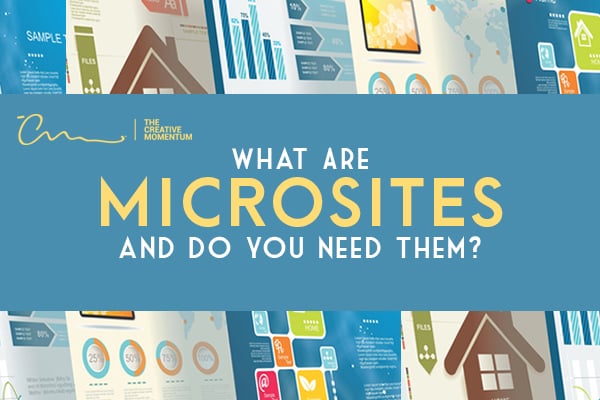 It can be hard to keep up with all the trends in marketing strategies. One you may not have heard of is microsites. Microsites are used by brands to develop products and services on an independent web domain.
It can be hard to keep up with all the trends in marketing strategies. One you may not have heard of is microsites. Microsites are used by brands to develop products and services on an independent web domain.
While microsites have their place, they may not be a great solution for all products or businesses. Let’s take a look at what microsites are, some of their advantages, disadvantages and whether you should consider integrating them into your web design strategy.
What Are Microsites?
Microsites are small websites that consist of no more than four or five individual pages. They’re constructed to meet a specific advertising objective away from the company’s main web address. While microsites are sometimes hosted as a subdomain off a larger site, a true microsite has its own independent address and structure.
For example, in 2016, Domino's pizza delivery chain began a new advertising campaign that featured branded delivery vehicles called DXPs. The new vehicles were the center of a variety of promotional efforts, and to support them, the company launched a microsite featuring information about the vehicles, interactive features, and a call to action that directed viewers to the nearest Domino's.
The campaign was successful, and the construction of a microsite helped localize a national advertising push.
Features of Microsites
There are a couple of important features that the majority of microsites share. In general, microsites are:
- Short Lived: The majority of microsites are designed to support specific initiatives and then they are taken down. This is to prevent the smaller site from competing with the main website.
- Separate: As noted above, microsites usually work best when given a separate domain from the company’s primary web address.
- Content Rich: A microsite is a targeted push for a single issue, and as such, have a large amount of content that revolves around specific keywords and one theme.
These limitations keep microsites from gaining the functionality that you'd expect of a primary webpage, and the content is meant to be accessed by the audience just once. While many microsites promote products, they rarely have their own ecommerce infrastructure, with companies preferring to funnel buyers back to the primary retail portal.
All of these components mean that microsites can be effective when targeting specific audiences and are an excellent tool for lead generation. Let’s take a look at some of the advantages and disadvantages of microsites.
Advantages of Microsites
Done well, microsites can deliver many benefits to your business. Here are some ways that microsites can help reach a specific audience.
Targeted Promotions
A microsite lets you create an experience that caters to a specific audience. This means that you can take risks in your messaging that might not speak well to a larger audience.
Microsites can be excellent for introducing new products to a specific audience. You can highlight benefits that may not matter to larger groups. You can also promote aspects of your brands that may only be of interest to a certain segment of your customers.
For example, clothing company Patagonia’s Blue Heart campaign microsite highlights the company’s efforts to save rivers in the Balkan region of Europe. While someone looking to buy a new jacket may not need to see this, the microsite supports one of the key ways the brand differentiates itself: Patagonia is notorious for its commitment to the environment. For consumers also deeply concerned with the environment, the microsite either introduces them to the brand or strengthens existing loyalty, because the company is aligned with and supports their core beliefs.
Focused Customer Experience
A typical company webpage has a lot of ground to cover. Products and services must be clearly detailed, support pages must be accessible and the company history should be available to newcomers.
A microsite sends visitors down a specific path with a single goal. This helps boost conversion rates. When customers are presented with specific advertising aimed at their niche, they are more likely to respond positively.
Boosted SEO
There are also SEO benefits associated with microsites. As these sites have their own domain addresses, they can be developed using specific keywords throughout the site and in page URLs. This helps boost search results and creates a pathway for customers to find you organically.
Disadvantages of Microsites
Before going full-throttle towards creating a microsite, there are some potential drawbacks to consider.
Visitor Confusion
Perhaps the most important issue surrounding microsites is the possibility of creating confusion among your target audience. If visitors to your primary website redirect to a microsite not meant to appeal to their specific interests, they may fail to return to the main website.
Beyond that, since most microsites don’t include a buy portal, this may cause enough confusion to discourage visitors from completing their purchase. Make sure your microsites have a clear pathway back to the primary website.
Microsites Require Resources
The next disadvantage of microsites is that they demand resources. These sites require the creation of their own content as well as development and design of the site architecture. And to achieve good search results, they'll need time to build domain authority.
You have already invested a significant amount of time, effort and money into developing an excellent online experience for your customers, and the prospect of doubling down on this may not fit your budget.
Do You Need a Microsite?
So, should you invest in a microsite? That depends on how your company interacts with its audience and how many niche groups there are. Microsites might be good for the following:
- You are operating a marketing campaign that would benefit from greater control of online interactions.
- The company has a product that it wants to separate from previous offerings.
- You want to create a clear pathway to complete a call to action.
- You want a site that focuses on just one aspect of your company’s services.
If you have a new initiative that fits within these constraints, then a microsite can be a great way to introduce a new concept and drive sales. Just make sure that it creates a positive pathway to the brand at large and doesn’t confuse potential new customers.


